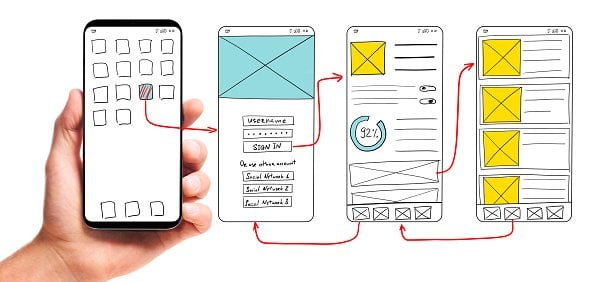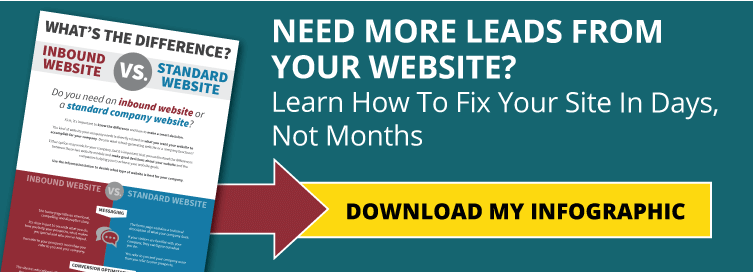
Website Strategy: A Blueprint For Your New Website Design
Massive E-Commerce Websites Delivered In Just 30 Days; Here’s How We Do It
You’re finally ready to redo your corporate website. The last time you did it you had a miserable experience. It took forever and included a ton of back and forth. In the end, it wasn’t exactly what you expected, and the website still doesn’t generate any real lead volume.
There has to be a better way, right? After all, that last website redo was a few years ago. It has to be easier and faster this time.
You might be right. But your experience has everything to do with who you partner with to build your website. You heard right — you’re looking for a partner, not a vendor or a website design shop.
You want a firm that specializes in helping you work out your website strategy, understands the visitor experience, knows that websites must generate leads and can apply technology to make it easy for you to use the site on your own when the new site is launched.
Here’s what you should be looking for when you consider rebuilding your new website.
Website Strategy
All websites are not created equal. Some are designed to be online brochures, some are designed to be corporate holding sites for investor relations and others are simple gateways to apps or other platforms.
All website design companies are not created equal either. Many are focused on how the site looks. Others are focused on the platform you build the site on. And still others rely heavily on templates that make it easy to deliver.
Your website should have one primary objective. Regardless of your size, your industry or the products/services you deliver, your website should be the cornerstone of your marketing and deliver leads — every day, every week, every month and every year.
Once you focus on that as your website strategy, the clouds will part, and everything will be much clearer and much easier.
This strategy has to direct every single decision you make, from what your site says to what it looks like, how you build it and the platform it’s hosted on.
Here are some examples.
What the site says means the headline on the homepage has to be disruptive, compelling and emotional. The copy on the site needs to be action-oriented, aligned with keywords for search strategy and focused on converting visitors into leads.
What the site looks like means the visitor’s experience needs to be easy to navigate, easy on the eyes, work well on all devices and clearly facilitate moving through the site efficiently.
How you build the site is very important so that it’s easy to make changes, upgrades and updates. The site also must load quickly on all the major search engines.
This also means building the site on a technology platform that ensures you get the analytics and performance expected to make solid decisions around the performance of the site.
As an example, today more B2B companies are starting to leverage e-commerce to drive revenue. With COVID-19, more sales reps are sidelined, and companies are looking to scale revenue through e-commerce. Here is a great example from a company that sells orthodontics products and supplies to orthodontists. We added a new e-commerce component to their site through a strong partnership with BigCommerce.
Once your strategy is laser-focused on attracting new visitors and turning those visitors into leads, the rest of the website build becomes much easier.
Website Blueprint
Just like building a new house, you need blueprints and architectural drawings to make sure that the foundation of your site is solid.
The website blueprints we do for all client websites are designed to make sure we have all of our question and answers resolved before we start any design or copy work.
The blueprint metaphor is perfect for this illustration. We create a blueprint for every single page on the website. We do an architectural map for the site that shows every page. We create the navigation design, and once that is done, we start drilling in on every single page.
The blueprint for each page includes (but is not limited to — we have to keep some stuff secret) the following:
- What we want visitors to see on this page (pictures tell stories, and people see images first)
- What we want visitors to read on this page (most people skim copy)
- What we want visitors to feel on this page (this is important, because people make purchase decisions emotionally and their feelings drive leads)
- What action we want visitors to take on this page
- What additional pages we want to direct them to
- What type of page it is (informational page, pillar page, a page for conversion, etc.)
- What stage in the buyer journey visitors will likely be in when they land on this page
- What role or persona will likely visit this page
- How we will turn visitors into leads and into sales opportunities on this page (if that is appropriate)
- How this page will be used for search engine optimization
- How our selected keywords get deployed on this page
All of these questions are answered before we even start designing or writing a single word of copy. This is one of our secrets to getting massive sites done in record time. You need solid planning, an innovate blueprint process and dedicated team resources.

User Experience
Great-looking sites aren’t enough today. Even the best-looking site runs the risk of failing from a lead generation and business growth perspective if you don’t have the user experience front and center in design.
This means you want more than a graphic designer or even a website designer leading the design effort on your new website. Instead, you want someone with a UI/UX (user interface/user experience) background.
UI and UX are different. The user interface is the graphical layout of a website. It consists of the buttons, links or icons users click on, the text they read and the images, sliders, text entry fields and all the rest of the items the user interacts with. This includes screen layout, transitions, interface animations and every single micro-interaction. Any sort of visual element, interaction or animation must be designed.
User experience is determined by how easy or difficult it is to interact with the user interface elements that the UI designers have created. Is the experience smooth and intuitive or clunky and confusing? Does navigating the site feel logical or does it feel arbitrary? Does interacting with the site give people the sense that they’re efficiently accomplishing the tasks they set out to achieve or does it feel like a struggle?
You want both UX and UI skills applied to your new website. You want someone who knows user interface design and can build a beautiful site that works elegantly.
You also want someone who understands what the user experience should be on your site. People can’t get lost or confused when visiting your site. Finding information has to be easy, or else they’re headed to your competitors’ sites.
Marketing-Qualified Lead Generation
As we said at the top of the article, your website has only one business objective, and that is to generate leads. To get leads the site has to attract visitors, and then the site has to turn visitors into leads.
It might sound simple, but you’d be surprised how many companies have websites that don’t generate any leads.
Let’s break this down. It’s clearly a two-step process. First, get people to your site, and then convert them from anonymous visitor into a marketing-qualified lead (MQL), or if possible, a sales-qualified lead (SQL).
Just so we’re on the same page, an MQL is someone who has expressed interest in your company. For example, they may have downloaded your content or chatted with you on your website.
An SQL is someone who has expressed interest in talking to sales or talking to you about doing business. They’re not educating themselves anymore; they want to talk about working together.
For your site to generate MQLs, you need the following:
- Solid offers on the site that align with the questions, challenges and pains your visitors are dealing with
- Offers that match the prospect’s buyer journey (for more info on the buyer journey and the value it adds to website lead generation, check out this page)
- Messaging, pages and offers that speak personally to people by role or industry
- Offers in a variety of formats like video, podcasts, infographics, e-books, research studies, tip sheets or checklists
- Strategically deployed call-to-action (CTA) buttons that turn visitors into leads
- Landing pages that excel at getting people through any resistance or friction associated with sharing their contact info
- Chat features that let you ungate the content but still generate leads and sales opportunities directly from the site
These important elements are missed frequently by website design shops that lack experience with lead generation. To make sure you don’t miss this, either define the goals of your site early and often, or make sure these items are in your scope and requirements doc.
Better yet, consider an agile delivery approach.
Agile delivery allows us to skip the requirements and scope effort. Not that we don’t like defining requirements, but we’ve found these to change frequently and for good reason. We might come up with a great idea, and clients often come up with great ideas. We want to be able to act quickly on those ideas.
Instead of defining requirements, we agree on a set of work to be delivered over a short period of time (we call it a sprint). Sprints usually run for a week or a month, depending on the amount of work to get done.
Then we deliver on the agreed set of work, sprint again and repeat this until we’re finished. It’s much more efficient, giving you more for your money.
Sales-Qualified Lead Generation
We’ve worked with many CEOs who are laser-focused on generating sales opportunities for their sales teams. We agree. While marketing-qualified leads are a measure of interest, and with solid nurturing they can become sales opportunities, we understand the need to measure a website’s effectiveness based on the number of sales-qualified leads the site creates.
Remember, SQLs are people who are proactively asking to talk to sales. Your website needs some very specific tools if generating SQLs is a top priority.
Specifically, you need late-stage buyer journey offers. These are offers that encourage, entice and reward people who are ready to talk to sales to ask for that meeting.
When we review websites for performance, these late-stage buyer journey offers are missing 95% of the time, and this is almost always the reason websites don’t generate more sales opportunities.
Here are some examples to get you thinking:
A safety products company offers a free audit of your factory floor. They’ll spend 30 minutes with prospects talking about their current safety protocols, then provide insights and recommendations on how to improve safety.
A concrete floor finishing company offers their prospects the ability to take pictures and send them in. They’ll then spend 30 minutes with a floor finishing expert reviewing the pictures and getting recommendations on how to improve the look of their concrete floor.
A tax accounting firm offers their prospects a tax savings review. They’ll spend 30 minutes talking about their situation and get specific tax savings ideas to consider, as well as an estimate on how much those ideas would save them in tax payments.
These offers all have something in common: They add value, and they’re not sales calls.
They allow reps to add value and then qualify the opportunity to see if it’s worth continuing. They’re not generic offers like get a demo, request a quote, speak to a rep or contact us.
These late-stage buyer journey offers are the key to driving sales-qualified leads and sales opportunities, and they’re easy to add. In fact, they’re much easier than early and mid-stage buyer journey offers that generally need copy, design and a more extensive website setup.
If you add these to your website, and continue to add them monthly while testing the performance, I guarantee you’ll increase the number of sales-qualified leads your website generates by a factor of 2x to 3x.
Interested in more details around these types of offers? Check out this article.
Tracking, Testing And Measurement
Since we’re talking about best practices and smart website project management in this article, I would never start a new website design project without knowing what quantitative gains you’re looking for prior to the project kicking off.
This means benchmarking your current site for at least these metrics:
- Visitors and new visitors each month
- Average site-wide conversion rate
- Number of MQLs and SQLs generated monthly
- Number of sales opportunities generated monthly
- Number of new customers and revenue generated from leads from the website
Of course, many more metrics are worth tracking, but these are enough to get you started. Once you have these baselined, decide what improvements you want from the site. These improvements should function as the foundation for decisions around design strategy, development planning and your website blueprint exercises.
This simple step is going to ensure you get the business outcomes you need from your project. For more innovative website designs, check out this site.

CEO and Chief Revenue Scientist
Mike Lieberman, CEO and Chief Revenue Scientist
Eliminate Hit-or-Miss Marketing Moves
Get advice, tips, tools and guidance to generate more leads for your company in this weekly email newsletter.



Eliminate Hit-or-Miss Marketing Moves
Get advice, tips, tools and guidance to generate more leads for your company in this weekly email newsletter.














